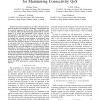Free Online Productivity Tools
i2Speak
i2Symbol
i2OCR
iTex2Img
iWeb2Print
iWeb2Shot
i2Type
iPdf2Split
iPdf2Merge
i2Bopomofo
i2Arabic
i2Style
i2Image
i2PDF
iLatex2Rtf
Sci2ools
113
click to vote
MDM
2010
Springer
2010
Springer
Timing and Radius Considerations for Maintaining Connectivity QoS
—Given the potential scale on which a Wireless Sensor Network (WSN) can be deployed, multi-hop communication will be a pivotal component of the system. When redundant nodes are deployed, which are hibernated opportunistically to conserve energy, it is crucial that sub-graphs of the network are not disconnected by the hibernation of a node. In order to ensure connectivity is preserved for all nodes in the area, a protocol is required that oversees routing integrity is maintained. Since this routing topology must be present at all times, this set represents the minimum number of nodes that must be active at any given time for a functioning network. In this paper, the performance of such a protocol is evaluated, in terms of message delivery and node lifetime for various timing and radius parameters. The selection of these, control the potential energy conserved by the nodes through the hibernation process, which can increase operational longevity. In addition, the radius governs the net...
Communications | MDM 2010 | Oversees Routing Integrity | Redundant Nodes | Wireless Sensor Network |
Related Content
| Added | 12 Oct 2010 |
| Updated | 12 Oct 2010 |
| Type | Conference |
| Year | 2010 |
| Where | MDM |
| Authors | Richard Tynan, Gregory M. P. O'Hare, Michael J. O'Grady, Conor Muldoon |
Comments (0)

